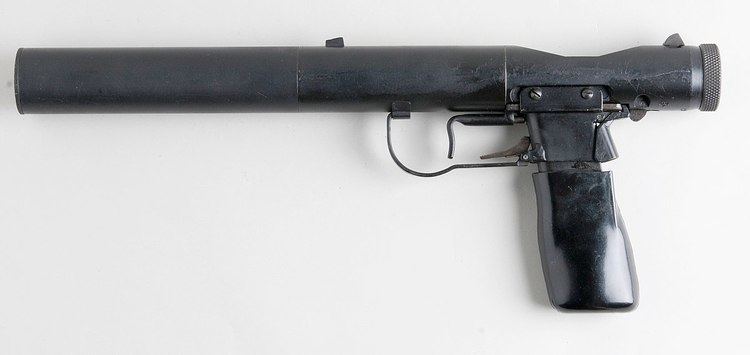Place of origin United Kingdom | Designed 1942 | |
 | ||
Wars World War II (known to have been used)Falklands War, Northern Irish Troubles, Desert Storm (reportedly used) Designer Inter-Services Research Bureau Manufacturer The Birmingham Small Arms Company LimitedUnnamed others manufacturers | ||
The Welrod is a British bolt action, magazine fed, suppressed pistol devised during World War II at the Inter-Services Research Bureau (later Station IX), based near Welwyn Garden City, UK, for use by irregular forces and resistance groups. Approximately 2,800 were made. The Welrod is an extremely quiet gun, being only 73db when fired.
Contents
History
It was used primarily by the British SOE but was also used by the American OSS and Resistance forces.
The Welrod was a "sanitised" weapon, meaning that it had no markings indicating its manufacturer or country of origin; all it was marked with was a serial number and some inscrutable symbols and letters. The Birmingham Small Arms Company Limited (BSA) confirmed that they manufactured some Welrod pistols, but that they put no markings at all on them, so it is likely that any markings were added by the British military after delivery.
The Welrod was used in Denmark during World War II, and is reported to have been used during the 1982 Falklands War, throughout The Troubles in Northern Ireland and during operation Desert Storm by British Special Forces. Welrod guns were also found in Gladio weapon caches.
Design
The Welrod took the form of a 1.25-inch-diameter (32 mm) cylinder, about 12-inch-long (300 mm) . The rear of the cylinder contained the bolt, the middle the ported barrel and expansion chamber of the suppressor, and the front the baffles and wipes of the suppressor. There was a knurled knob at the rear that served as the bolt handle, and the magazine was also the grip. Removing the magazine/grip made the weapon easier to conceal.
The Welrod was provided with sights marked with fluorescent paint for use in low light conditions. Although it had a maximum suggested range of 25 yards it was intended for use far closer—up to point-blank range. The muzzle end of the gun was cut away so that it could be fired in direct contact with the target. This would reduce the sound levels even further and remove the chance of missing.
The ported barrel of the Welrod served two purposes: it released the powder gases gradually into the rear of the suppressor, reducing the sound of firing, and it reduced the velocity of the bullet to subsonic speeds (especially important in the 9 mm version since the standard 9 mm loading is supersonic). The baffles and wipes that follow the barrel serve to further slow the gases of firing, releasing them over a longer period of time and avoiding the sharp explosion that occurs when high pressure powder gases are suddenly released to the atmosphere.
The Welrod used a bolt-action design because it was simple, reliable and quiet. The bolt-action has only the noise of the firing pin hitting the primer, and the bolt can be cycled quietly.
The Welrod was extremely quiet for a gun, producing a sound of around 73 dB when fired. Examples were made in 9mm and .32 ACP, with magazines of six and eight rounds respectively.
Operation
The pistol is manually operated using a rotary bolt, locking with two lugs. Loading is performed with a pull/push action using the round knurled knob to the rear of the weapon. The trigger is single stage with a simple safety at the back of the magazine housing. The detachable single stack magazine contains six or eight rounds (depending on calibre) and serves as a pistol grip with the bottom part enclosed into the plastic cover.
Name
The name Welrod comes from the custom that all the clandestine equipment devised at Station IX in Welwyn Garden City had names starting with Wel, e.g., Welbike, Welman. A document was produced towards the end of World War II to ensure that the right persons were properly credited for their inventions at Station IX. This document reveals that the inventor of the Welrod was Major Hugh Reeves who was also responsible for the sleeve gun (similar to the Welrod, though single shot and intended to be concealed up a sleeve) and several other important inventions.
